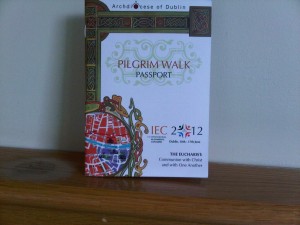One of the unique events of this Eucharistic Congress in Dublin is the Pilgrim Walk. Noting the revival of people’s interest in pilgrim walks, the Congress committee created the route around seven of the oldest churches in Dublin. Readers of this blog from the Archdiocese of Washington know of the annual Seven Churches Walk sponsored by our Young Adult Ministry and this Dublin walk is very similar.
interest in pilgrim walks, the Congress committee created the route around seven of the oldest churches in Dublin. Readers of this blog from the Archdiocese of Washington know of the annual Seven Churches Walk sponsored by our Young Adult Ministry and this Dublin walk is very similar.
I began my walk with Mass and the Reconciliation at St. Mary Pro-Cathedral, the mother-church of the Archdiocese. I wound my way through the city, stopping at St. Anne’s, founded in 1723 where Irish poet and writer, Oscar Wilde was baptized. At St. Anne, there is a bread shelf located by the choir. It was a tradition to stack the shelves with loaves of bread which the hungry and poor were welcomed to take. From St. Anne’s, I headed for Our Lady of Mt. Carmel, home of the Carmelite Fathers and established in 1279. Here pilgrims had a chance to venerate the relics of Saint Valentine.
From St. Anne, on my way to St. John’s Lane Church I passed the house where Frank Duff founded the Legion of Mary in 1921. St. John was built by the Augustianians in 1280 and this year has been a special one for the parish as it celebrates the 150 Anniversary of the “Solemn Blessing and Laying of the Foundation Stone,” on Easter Monday in 1895. Not far from St. John’s and in the very neighborhood that is home to Guinness’s Beer world headquarters and plant is St. James church, St. James, founded in 1844, has a special link to the Camino de Santiago as many Irish pilgrims have their Camino passport stamped at St. James before starting out for Camino de Santiago de Compostela.
The sixth visit was to the Gothic style Church of St. Mary of the Angels, which started as a chapel site around 1689, following the Battle of the Boyne. This really beautiful church with a rich wood ceiling was established in 1868. I ended my pilgrimage at the parish of St. Michan, the oldest parish in Dublin. Historical records show the presence of a Christian Shrine dating back 1,000 years, though the present church was not constructed until 1730. The presence of a chapel for some 1000 years has some support in the fact that at the Episcopal Church also named St. Michan, in the same neighborhood, there are catacombs with graves that have been dated at 800 years.
This pilgrim walk was not just a history lesson, but a time for extended prayer in front of the Blessed Sacrament. A number of the Churches have extended hours of Exposition during the Congress and many added Masses so that pilgrims can take full advantage of this time of walking with Our Lord. In prayer, one is able to recall themes from the homilies and catechetical sessions that come alive in private prayer and to pray for God’s blessing that the fruits of the Congress will be carried to the home dioceses and parishes of the pilgrims. At each church, pilgrims end their time of private prayer with this prayer:
Lord Jesus, you were sent by the Father to gather together those who are scattered.
You came among us, doing good and bringing healing, announcing the Word of Salvation and giving the Bread which lasts forever. Be our companion on life’s pilgrim way.
May your Holy Spirit inflame our hearts, enliven our hope and open our minds,
So that together with our sisters and brothers in faith we may recognize you
in the Scriptures and in the breaking of the bread. May your Holy Spirit transform us into one body and lead us to walk humbly on earth, in justice and love, as witnesses of your resurrection.
In communion with Mary, whom you gave to us as our Mother at the foot of the cross, through you may all praise, honor and blessing be to the Father in the Holy Spirit and in the Church, now and forever. Amen
